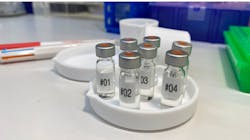Potential game-changer: Topical gel to help fight gum disease
Citing an “urgent public health need for more targeted and effective treatments for [gum disease],” researchers at NYU College of Dentistry have developed a topical gel that treats gum disease by suppressing inflammation and changing the makeup of oral bacteria.
The research, published in Cell Reports, was conducted in mice and using human cells and plaque samples, and could lay the groundwork for a topical, at-home treatment for periodontitis, which affects nearly half of adults over the age of 30.
"No current treatment for gum disease simultaneously reduces inflammation, limits disruption to the oral microbiome, and prevents bone loss. There is an urgent public health need for more targeted and effective treatments for this common disease," said Yuqi Guo, an associate research scientist at NYU Dentistry and the study's co-first author.
The study focused on the connection between succinate, a metabolic byproduct, and gum disease, with higher succinate levels associated with higher levels of inflammation. In 2017, researchers reported that elevated levels of succinate activate the succinate receptor and stimulate bone loss.
In the new study, researchers found higher succinate levels in people and mice with gum disease compared to those with healthy gums, confirming previous studies on the link.
To test the connection between the succinate receptor and the components of gum disease, researchers genetically altered mice to inactivate, or “knock out,” the succinate receptor.
In “knockout” mice with gum disease, the researchers measured lower levels of inflammation in both the gum tissue and blood, as well as less bone loss. They also found different bacteria in their mouths: mice with gum disease had a greater imbalance of bacteria than was present in “knockout” mice.
Researchers developed a gel formulation of a small compound that targets the succinate receptor and prevents it from being activated. In laboratory studies of human gum cells, the compound reduced inflammation and processes that lead to bone loss.
They then applied the compound as a topical gel to the gums of mice with gum disease, which reduced local and systemic inflammation and bone loss quickly—in a matter of days. What’s more, mice treated with the gel had significant changes to the bacteria in their mouths, with specific bacteria dominant in gum disease depleted in those treated with the gel.
Researchers are continuing to study the gel in animal models to find the right dosing and timing for application, as well as determine any toxicity, with the long-term goal of developing a gel and oral strip for home use by people with or at risk for gum disease.
Primarily sourced from NYU's press release: Gel treats gum disease by fighting inflammation
(Content edited for style and length)
